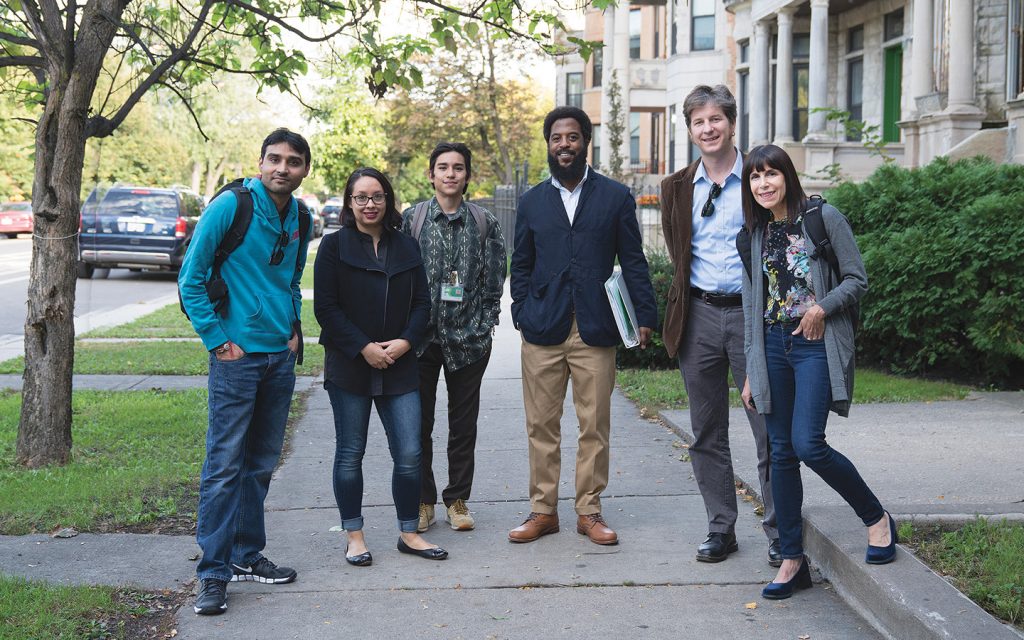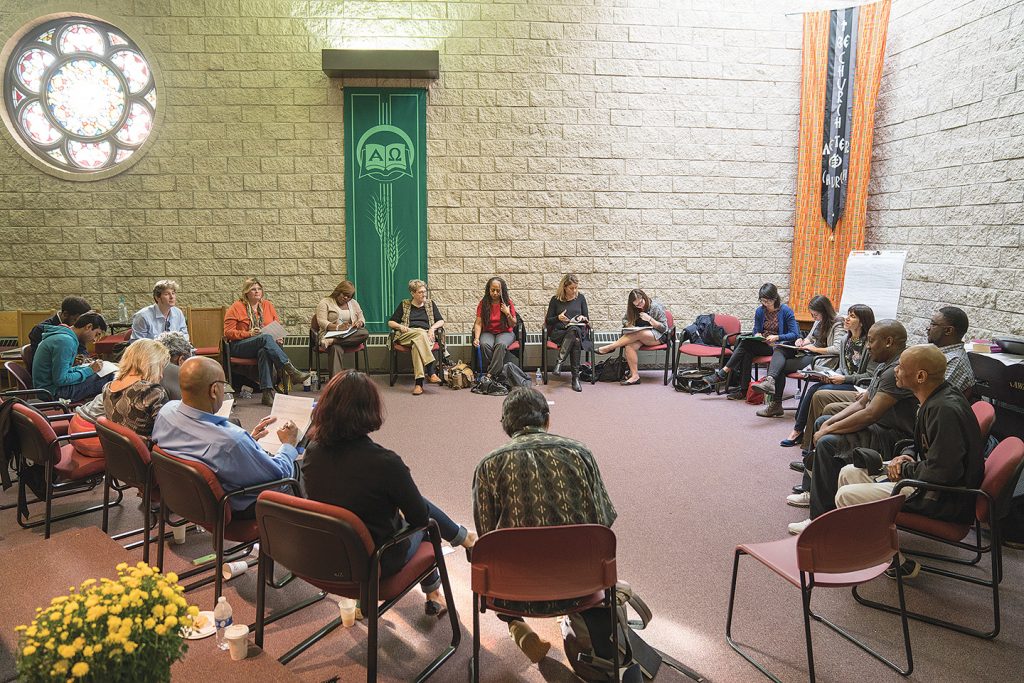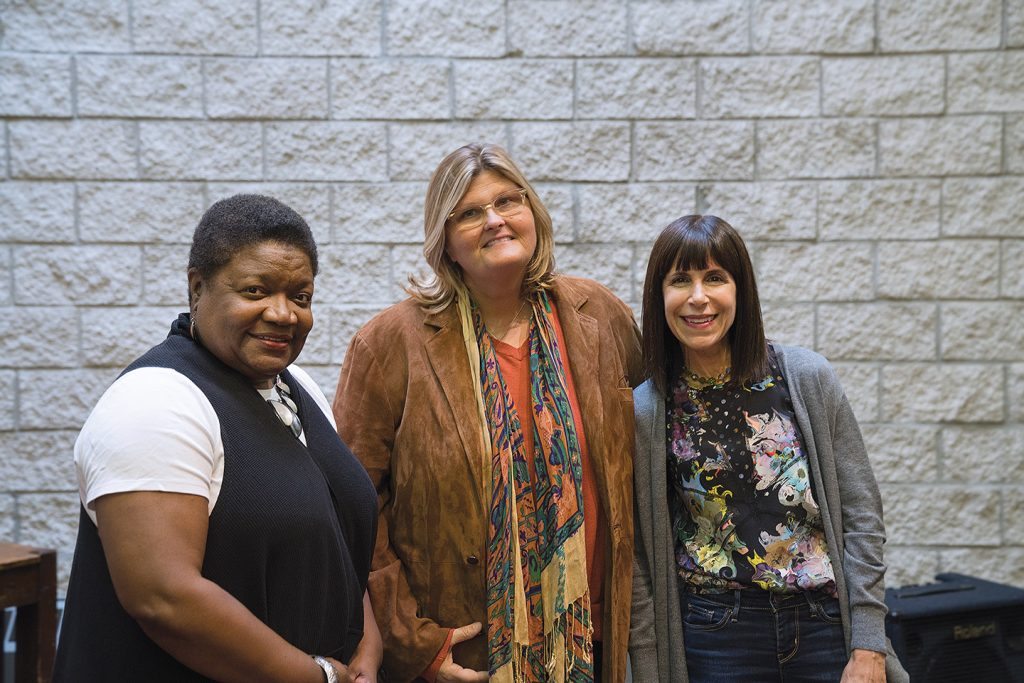
Left, in Chicago’s North Lawndale: Roosevelt accounting student Bajesh Punjwani, Mansfield’s Lyly Harrington, Roosevelt sociology students Edgar Moreno and Shanti Brown, Roosevelt professor Edward Green and Mansfield’s Nancy Michaels.
A shift in thinking about how we deal with conflict, crime and violence is taking place in Chicago and beyond, and Roosevelt University’s Mansfield Institute for Social Justice and Transformation has a major stake in it.
Founded in 1999 as the University’s social justice arm, Mansfield got its start planning social-justice lectures that frequently have drawn hundreds of people to campus. Today, the organization is leading frank discussions, often called circles, on ways to fix our broken criminal justice system.
“We don’t get to know one another the way we used to,” said Heather Dalmage, director of the Mansfield Institute, which, since 2010, has been working to rescue vulnerable youths from the grasp of gangs, drugs, crime and prison. “We’ve got to be able to think together about how to create needed social changes. Otherwise, we’ll never be able to get at the root of what’s causing these problems.”
“We’ve got to be able to think together about how to create needed social change.”
Heather Dalmage Director, Mansfield Institute for Social Justice and Transformation
Now being tried with young people around the nation as a way to nip conflicts before they turn violent or criminal, this approach is called restorative justice, and it’s picking up steam from Chicago to London, and Colorado to West Virginia.
“We’ve been stuck in a cycle of punishment: black and brown young people getting in trouble at school and suspended, then being arrested in school and in their communities, unnecessarily criminalized and sent down the path to prison,” said Nancy Michaels (BA, ’07; MA, ’10), associate director of the Mansfield Institute.
“People all over are realizing that this way of doing things isn’t working. It’s damaging lives and communities, and we have to find alternative solutions,” she said.
Restorative justice has roots in indigenous cultures that for years have used circle practices to build relationships and strong communities. Building on these traditions, modern-day founder, Mennonite and American criminologist Howard Zehr, who in 1990 wrote Changing Lenses: A New Focus for Crime and Justice, encourages us to move toward building communities and away from building a world of punishment. For example, when wrongdoing or crime occurs , he encourages us to ask “Who was hurt?” and “What are their needs?” instead of “What laws have been broken?” and “What do the offender(s) deserve?”
“Our goal is to shift the way we think about and do justice,” said Michaels, who has been leading the development of restorative justice thinking and practices in schools, the criminal justice system, throughout Chicago and at Roosevelt University. “It’s about changing hearts and minds, and building public and political will that results in policy change. While this has been a slow process, we are certainly beginning to see a shift,” she said.

Court planning sessions include circle discussions.
There is a national buzz today, like never before, about the value of restorative justice: It’s been highlighted extensively recently as having potential to heal rifts and mend troubled lives by the New York Times Magazine, Wall Street Journal and USA Today; It’s also been piloted, primarily as an alternative to school suspensions, in places like New York City, Denver and Oakland, Calif.
“We’re at a point where we don’t have to spread the word quite as much on what restorative justice is all about,” said Sara Balgoyen, president of the Illinois Balanced and Restorative Justice Project. “Clearly, the Mansfield Institute is one of the players who has helped move the cause forward.”
Among steps taken, the Mansfield Institute has brought together under one umbrella called “The Embrace RJ in Schools Collaborative” more than 40 grassroots groups in Chicagoland that subscribe to implementing restorative justice in all schools.
Led by Michaels, the group crafted guidelines for using restorative justice practices, including circles, in the Chicago Public Schools, and also has been active in teacher and principal training.
“We’re moving toward a system-wide, restorative-justice school district,” said Jean Klasovsky, a restorative practices specialist at CPS, “and Embrace RJ helped us put together the framework.”
Now Mansfield is on the verge of impacting lives and policy as one of the advisers for the nation’s first Restorative Justice Community Court, opening in Chicago in 2017. The expertise and leadership of Michaels and the Mansfield Institute have been pivotal to the creation of this court.
In fact, Cook County Circuit Court Judge Colleen Sheehan, a 16-year veteran who has seen young people repeatedly cycling through her courtroom, emphatically stated, “We are entering unchartered waters with this innovative project, and I can tell you right now that there would be no court without Nancy and the Mansfield Institute.”

Roosevelt Assistant Professor of Criminal Justice Edward Green and Cook County Circuit Court Judge Colleen Sheehan.
Sheehan worked closely with Michaels and Cook County Circuit Court administrator Michelle Day to develop a plan for the court that will be housed in Chicago’s west-side North Lawndale neighborhood where 70 percent of male residents have felony convictions.
The pilot court, which could become a model, will be for 18 to 26-year olds accused of nonviolent misdemeanors and first-time felonies committed in North Lawndale.
“We are entering unchartered waters with this innovative project, and I can tell you right now that there would be no court without Nancy Michaels and the Mansfield Institute.”
Judge Colleen Sheehan
They would be asked to voluntarily participate in circles/conferences with their victims, and the goal would be to: give them a better understanding of harm caused so they accept responsibility; award restitution repairing harm done to victims and the community; and provide resources, such as mental health or drug treatment and job training, that can put offenders on a positive track.
“This is huge. It’s a project that has international significance,” said Elizabeth Clarke, president of the Illinois Juvenile Justice Initiative, which recently put the Mansfield Institute on an international restorative justice delegation visiting England last spring. “We are giving the community ownership of the court and allowing them to deal with these cases as they see fit, and that’s something that’s not been done before,” she said.
The Mansfield Institute will evaluate the court’s effectiveness with help from approximately 20 Roosevelt students who will be surveying North Lawndale residents.
“I’m interested in this project because it’s near my home and I’ve seen the damage that’s been done with young people who have been convicted of crimes and can’t find work,” said Emmanuel Corde, a sociology student who will survey in North Lawndale as part of a Research Methods class. “I want to support our future and change the world we live in.”
The court project is but one example of the Mansfield Institute’s social justice work, according to Roosevelt University Trustee Meme Hopmayer, whose Albert and Anne Mansfield Foundation created and has financially supported the Institute.

Restorative justice court planners include Cook County Circuit Court Administrator Michelle Day, Judge Colleen Sheehan and Roosevelt’s Nancy Michaels.
“I’m proud of what’s been accomplished with this project, and I particularly love that Roosevelt has engaged students in going out, learning about and contributing to the work,” she said.
Looking forward, the Mansfield Institute wants to encourage neighborhood connections that can help transform Chicago into a restorative justice city.
“Our goal is to shift the way we think about and do justice.”
Nancy Michaels Associate Director, Mansfield Institute for Social Justice and Transformation
“We’ve talked quite a bit about it, using circles of healing to create positive values that we can live by – block to block, police to community, city hall to downtown and its neighborhoods,” said the Rev. David Kelly, executive director of the Precious Blood Ministry of Reconciliation. “Roosevelt has been active in this, and is one of our partners in our campaign,” he said.
Now in its 17th year, the Mansfield Institute also is aiming to make Roosevelt a restorative justice university. “If not at Roosevelt, then where?” asked Dalmage.
So What is a Restorative Justice University?
![Above: Roosevelt sociology student Edgar Moreno and Mansfield’s Lyly Harrington.] It can be a place where research, teaching, training and technical assistance for all kinds of restorative justice projects are housed, such as at Skidmore College in New York, which has its own Restorative Justice Project.](http://blogs.roosevelt.edu/review/files/2017/01/photo-5-1024x683.jpg)
Above: Roosevelt sociology student Edgar Moreno and Mansfield’s Lyly Harrington.
It can be a place where research, teaching, training and technical assistance for all kinds of restorative justice projects are housed, such as at Skidmore College in New York, which has its own Restorative Justice Project.
It can be a center for learning through webinars and videos, which the University of Minnesota’s Center for Restorative Justice and Peacemaking widely offers.
And it is a university that is steeped in the values and practices of restorative justice.
Use of restorative justice circles and peer conferences can be specific to student conduct proceedings, which the University of Denver advocates when cases involving student conduct are being resolved; or the use of circles can have a simple aim of relationship building, which is to put ALL people in a community, no matter rank or stature, on track to share values, uniting them to work together toward positive change.
“These were strangers I hardly knew,” said Roosevelt student Elizabeth “Lizzie” Sharp, who remembers being moved as she sat in circle during Mansfield’s Social Justice Summer Institute where students shared personal reflections on what’s wrong with and how to fix the criminal justice system.
“Once people started opening up, it became easier to share,” said Sharp, who believes a restorative justice university should be about building bridges. “There was this connection that all of us felt in that circle, and to this day, most of us are still in contact. We’ve become friends and activists working together.”
Roosevelt President Ali Malekzadeh had a similar experience when he joined a Mansfield-led circle seeking healing after the fall 2015 release of a video showing Chicago police shooting teen Laquan McDonald.
“There was a lot of pain being expressed, and I was just as angry and sad as everyone in the room,” said Malekzadeh, who remembers several students being uneasy about violence in their own neighborhoods, including police showing up with guns drawn.
“It was important for me to learn what some of our students are going through, and to know that they have a safe place at Roosevelt where they can go to heal,” he said.
“All of us in that room wanted to get beyond the shooting,” he added. “There was a bond and a commitment there to work together for something better.”
That is exactly the kind of spirit that the Mansfield Institute hopes to further ignite as it moves forward in transforming Roosevelt into Illinois’s first restorative justice university.
Among goals will be to: develop university-wide values, policies and procedures; create safe spaces for discussion of difficult topics and to address student concerns or conflicts; provide training for community members, including Roosevelt’s new eight-member student conduct board; and include restorative justice practices as part of coursework in applicable areas, such as for those studying to become counselors or teachers, said Nancy Michaels, associate director of the Mansfield Institute.
“Restorative justice is aligned with our social justice mission,” said Michaels, “and as a result, a restorative justice university will be that much easier to achieve.”
Leave a Reply